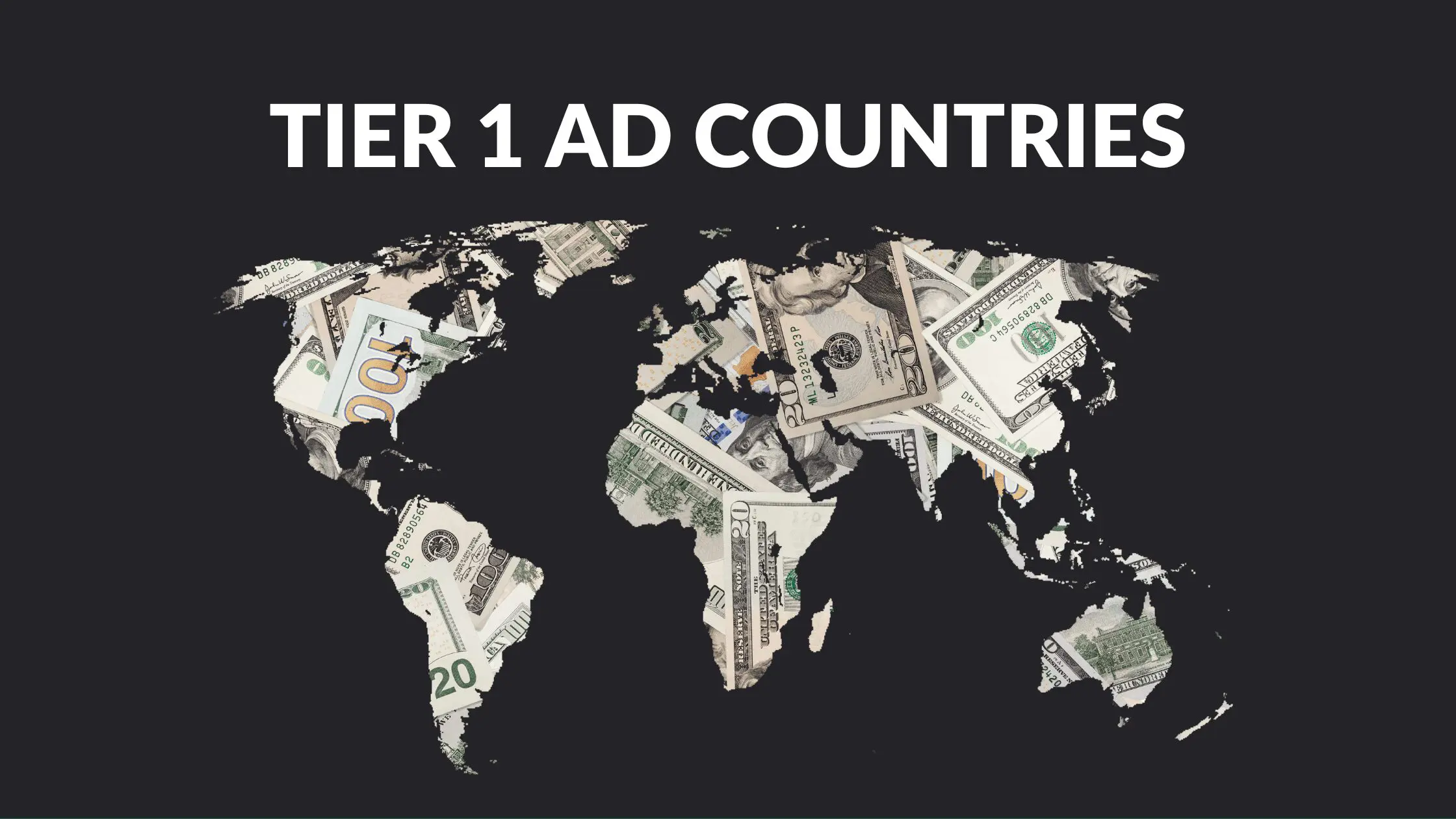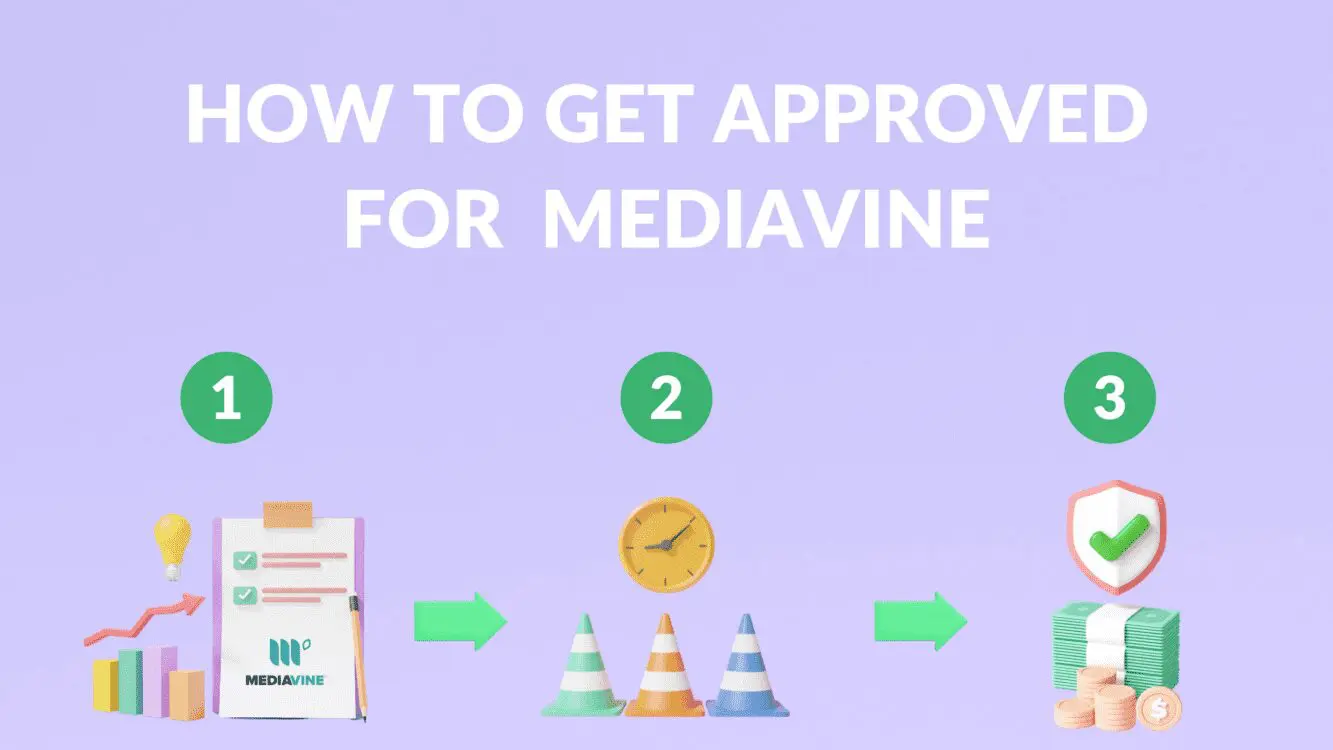What Are Tier 1 Ad Countries? (And How They Affect Display Ad Income)

Written by Casey Botticello
Disclosure: Some of the links below are affiliate links, meaning that at no additional cost to you, I will receive a commission if you click through and make a purchase. Read our full affiliate disclosure here.
Digital advertising is all about putting the right ad content in front of the right people. But it’s also about getting the most value out of your investment, and some markets offer more attractive returns than others.
But how do advertisers know which markets offer the biggest rewards for advertising in them? They divide them into levels or ‘tiers.’ More specifically, they categorize them by country.
Tier 1 ad countries are considered the most lucrative markets with the highest revenue potential. Tier 2 and 3 countries also have tremendous display advertising potential but are not nearly as attractive as those at the top.
Brands and companies want to advertise in the markets that have the most money, can understand their content, and relate to what they’re saying. So, they work with display ad networks that understand where these markets exist and how to access them online.
Networks then partner with bloggers, content creators, and website owners whose traffic originates in the markets and countries advertisers are aiming to reach.
We explore how brands, companies, ad networks, publishers, and bloggers work together to promote their advertising content in the most lucrative Tier 1 ad countries.
From how ad network traffic thresholds determine eligibility to what you need to do in order to qualify as a ‘Tier 1’ blogger, this article will help you get a better understanding of what are Tier 1 ad countries and how tiers affect display ad income.
Display Advertising 101

Let’s first look at how the online display advertising industry works before diving into how we assign different ad network tiers to different countries and what ad network traffic thresholds mean for everything.
There are three players in the display ad game:
- Advertisers – like brands and companies who pay ad networks to post their ad content onto publishers’ websites.
- Publishers – like bloggers and website owners who get paid for allowing ads to run on their sites.
- Display Advertising Networks – who get paid by brands and companies to advertise on the right websites and, in turn, pay publishers for letting them do so. Check out these top ad networks used by bloggers.
Ad networks will collaborate with a brand or company to ensure their advertising and marketing content reaches the right audiences.
Once they know whom to target and where they engage with their publisher partners to find the sites and blogs frequently trafficked by the markets they’re looking to reach. Now you can see how tiers affect display ad income.
To learn more about who these ad networks are and how much you can make from partnering with them, take a look at our comprehensive blog ad networks resource.
What are Display Advertising Tiers?

Ad networks need to reach the markets that will provide the best return for the advertising efforts of their clients. So they conduct extensive research to determine which countries, demographics, and markets are ideally suited to their clients’ needs.
Importance of display ad tiers
To do this (and to better understand what are Tier 1 ad countries and which markets the networks see as the best ones), the display ad industry keeps us updated on which markets are the most profitable. They do this by arranging them, by country, into tiers.
Tiers are then used to target ad content to audiences in specific countries. Advertisers use this category system to identify which blogs and websites receive the most traffic from the relevant markets, choosing whether or not they want to partner with them.
Not all ad markets are considered equal
There are three tiers altogether. Each one contains a list of countries arranged according to the various demographic and economic factors most likely to influence the profitability of advertising in them.
The wealthiest countries, whose audiences have high levels of disposable income, are ranked as Tier 1 countries. Less-developed nations and those countries with fewer resources – and thus less likely to convert into customers – are listed further down in Tiers 2 and 3.
But it’s not all about where the market’s traffic originates. Elements like language, education, advertising costs, competition, and even local laws influence whether a country is considered a Tier 1 country or not – impacting on how tiers affect display ad income.
What Countries Are Considered Tier 1 for Bloggers Applying to Display Ad Networks?

When looking at display ad networks for bloggers, there are generally five countries that all networks recognize as tier 1: United States, Canada, United Kingdom, Australia, and New Zealand.
If you expand the list to include advertisers with a larger inventory and a more global focus, tier 1 ad networks often include many European countries, as well as a few high income countries throughout the rest of the world.
How Ad Networks Use Tiers (+ Examples)

There isn’t a single person who decides which countries belong to which tiers. The listings are usually broadly agreed upon by the display ad industry. However, some ad networks may differ in their listings compared to others in defining what are Tier 1 ad countries.
For a country to drop down the tier rankings, something drastic would need to happen, like a war breaking out or a financial crisis, that would make the country less desirable as an advertising destination.
Some countries also fall in between tiers. For example, a list-topping Tier 2 country may actually be a better advertising prospect than a low-level Tier 1 country, or one ad network may value a nation’s special characteristic more than another’s.
Let’s take a look at these different ad network tiers to see how they differ from each other.
Tier 1 Ad Countries
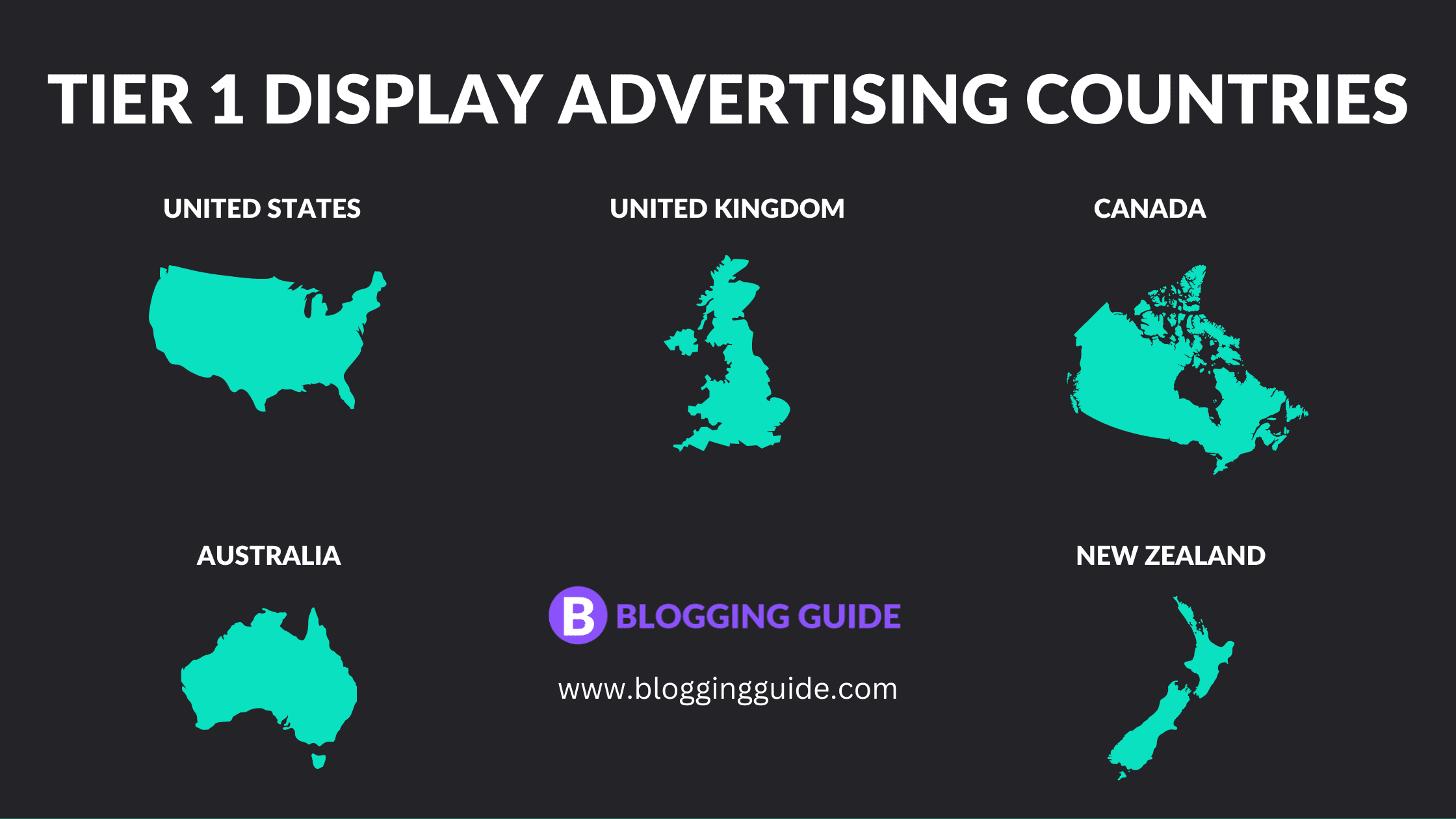
Tier 1 countries are considered the most desirable advertising markets. These countries boast high levels of wealth and are very well-developed. People living in these countries enjoy a high degree of disposable income, making them more likely to spend, most people have access to the internet (and they understand how to use it), and English is the main language.
- Demographics – Highly educated, large disposable income, high likelihood to spend, and near-universal internet access.
- Advertising competition – High, with many different ad networks, brands, and publishers all competing for market share.
- Cost to advertise – Expensive, with advertising prices exponentially more expensive than in Tier 2 and 3 countries.
- Language – English is the first language for almost everyone, with non-native English speakers very capable of understanding and speaking the language.
- Example countries – United States, Canada, United Kingdom, Australia, and New Zealand
Note: As mentioned previously, these 5 countries are the “gold standard for display ad networks as it relates to blogging, specifically. When looking at display ad networks with larger inventory, tier 1 ad networks often include many European countries, as well as a few high income countries throughout the rest of the world.
Tier 2 Ad Countries
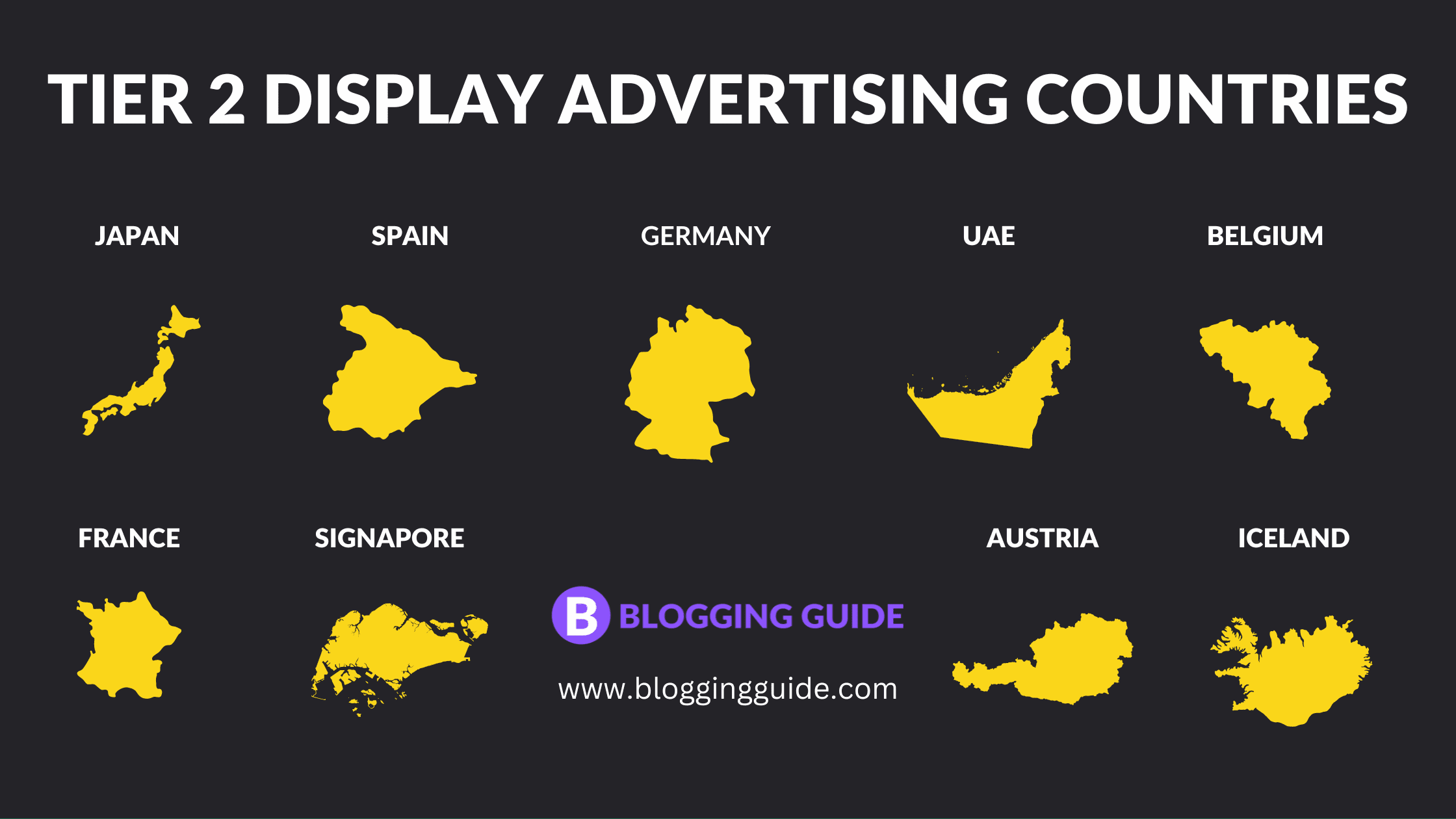
Tier 2 countries make up the bulk of those listed and consist mostly of nearly developed or developing economies. These countries aren’t always the best advertising opportunities, but they are still great prospects. While some of these countries may be considered Tier 1 options at first glance, one or two factors often prevent them from making it onto the ultra-lucrative Tier 1 list – usually owing to language barriers.
- Demographics – Average incomes with rather well-developed economies and wide ranges of disposable income. In-store shopping trends match the likelihood to spend online, and internet access is almost universal.
- Advertising competition – Average. The more developed the country, the higher the advertising competition. Some Tier 2 countries have tough advertising markets, while others are less challenging to break into.
- Cost to advertise – Depending on the country, advertising costs can vary. Due to discounted CPC prices, however, advertising in Tier 2 is far cheaper than advertising in Tier 1 countries.
- Language – While English is generally spoken, it may or may not be as widespread. Most people in these countries have English as a 2nd or even a 3rd language.
- Example countries – Spain, Germany, Iceland, and many other almost-developed or strong developing countries.
Tier 3 Ad Countries
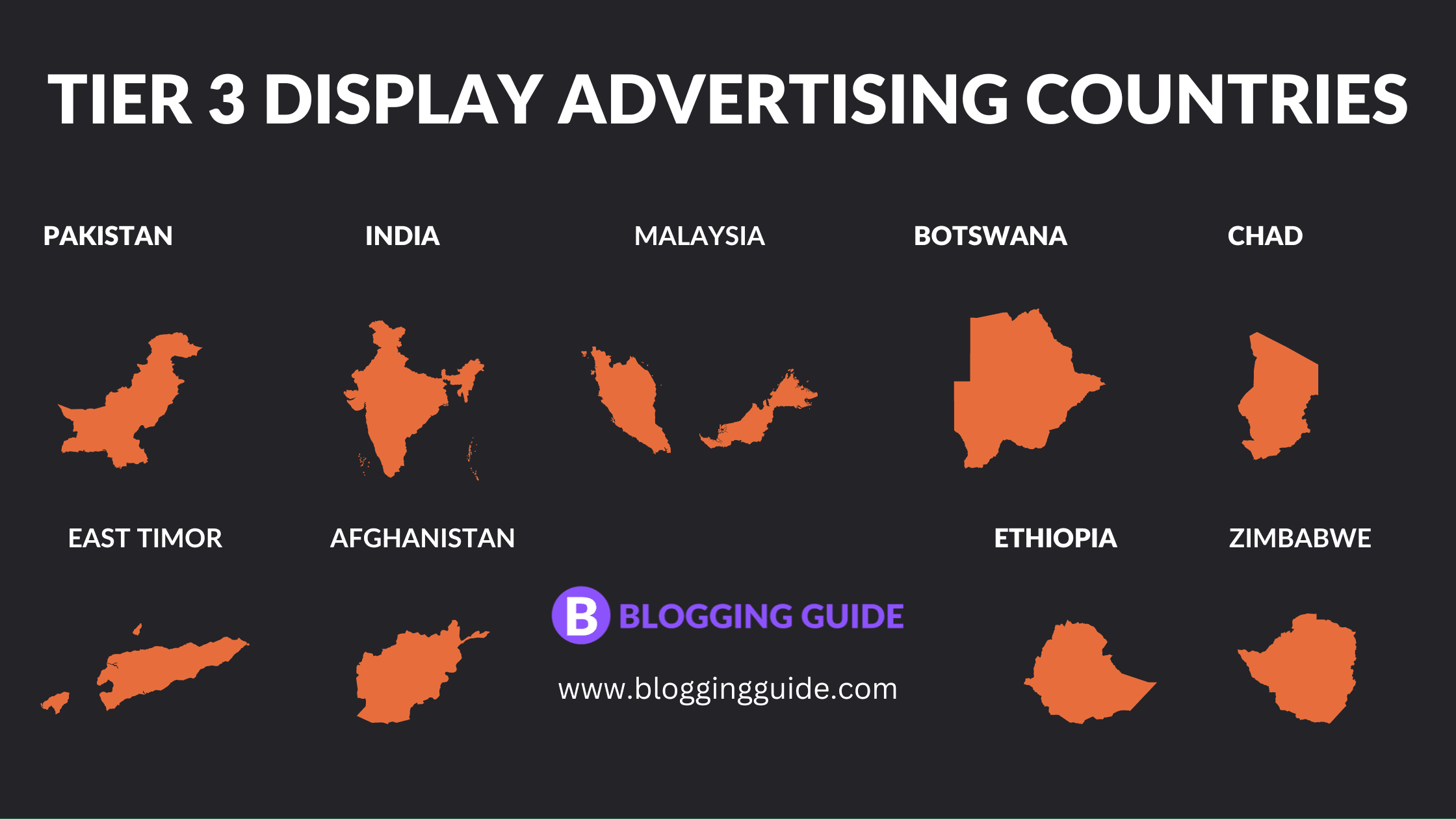
Tier 3 countries consist of those nations where advertising is largely more difficult. Whether due to the absence of English as a major language, financial hardships, or social problems, website traffic from these countries won’t count for much among ad networks.
- Demographics – Low GDP and education levels, with most means to spend dedicated to making ends meet. Internet access is often limited, and markets have very restricted disposable income.
- Advertising competition – Low. While this may appear to present a good advertising opportunity, the lack of competing advertisers is a symptom of an unattractive market.
- Cost to advertise – Very cheap, due to there being limited competition and opportunities.
- Language – English is absent or spoken very poorly. Most transactions and day-to-day activities occur in local dialects.
- Example countries – India, Ethiopia, Pakistan. There are many African and Middle Eastern countries on this list.
Ad Networks and Your Traffic

There are many ad networks out there catering to different markets and publishers. Some are all about volume, allowing anyone to advertise with them or join their programs. These networks, however, often pay lower commissions.
Others are premium networks with strict application requirements and selective, high-paying clients. These premier programs are where you want to end up, earning impressive RPMs for your advertising efforts and making a big difference in how tiers affect display ad income.
Where traffic fits in
Ad network tiers are used to understand which publishers would be the best fit for their advertising clients. More specifically, they want to know where those publishers’ traffic comes from – and how much of it their websites and blogs receive. For this, they list different requirements, including ad network traffic thresholds and where your traffic comes from.
When applying to join an ad network, you will first need to prove:
1. How many impressions, page views, or sessions your site receives, on average, every month.
2. And where that traffic originates from, as well as how it reaches your blog.
Ad networks use this data to decide whether or not to admit you to their programs based on their clients’ needs. You’ll likely need to have software running that records and measures your blog’s performance – usually Google Analytics.
Ad network traffic thresholds
Ad networks require sites and blogs to have a minimum number of visits or views before admitting you to their program. These thresholds vary between different networks, and some have no thresholds at all.
These thresholds are measured as monthly averages and should be stable in order to be considered for a program. Here are some examples of what these ad network traffic thresholds are for some of the most well-known ad networks: (Note – these thresholds may change).
- Google AdSense – No minimum traffic requirement
- Monumetric – 10,000 page views per month for their lowest-tier program
- Ezoic – 10,000 monthly page views minimum traffic requirement
- Mediavine – Between 60,000 and 80,000 page views per month (50,000 sessions, to be exact)
- AdThrive – 100,000 monthly page views
As you can see, some networks have no thresholds, while some require high traffic activity before considering you. But it’s not all about how much traffic your site receives – where it comes from and how it reaches you matters too. This is where understanding what are Tier 1 ad countries comes in.
Traffic origins
Ad networks want lots of traffic to see their ads. But they also want relevant traffic – traffic that plays a big role in how tiers affect display ad income. To do this, networks will review:
- Traffic type – Whether most of your traffic arrives in the form of desirable organic traffic or if it is being driven from other (non-organic) sources.
- Niches & market access – Is your traffic niche specific? In other words, are most of your visitors easily quantifiable as “profitable” and thus more likely to convert?
To get a better picture of your traffic origins, ad networks will look at where your traffic arrives from.
- Country – This is a crucial metric for ad networks. If most of your traffic originates in a Tier 1 nation, you’re a much more attractive publishing prospect.
Most applicants to various ad network programs will need to have metric monitoring tools installed, like Google Analytics, allowing them to access standard traffic measuring methods and specifications.
Ad Networks and Your RPM

Understanding how tiers affect display ad income is key to maximizing it. Display advertising income is determined by looking at revenue per mille (RPM). This indicates how much you can expect to earn for every 1,000 pageviews, sessions, or visitors (whichever metric you’re using) your site receives.
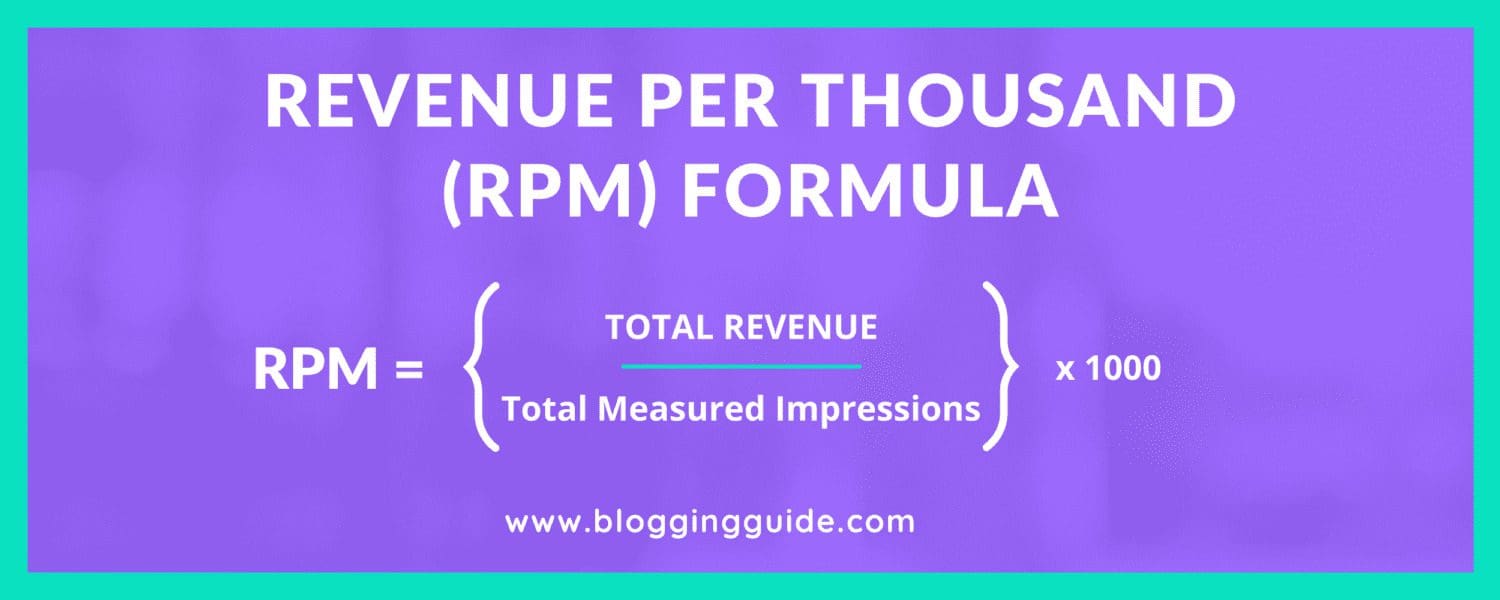
Ad networks calculate the commission they pay to publishers based on different levels of traffic a website receives so long as it exceeds the ad network traffic thresholds. The more traffic and the better its ‘quality,’ the higher your RPM. But the value of your traffic matters too.
Traffic that originates in a Tier 1 country usually has more money to spend, is more likely to convert, and most of the top ad networks’ clients are based in these countries, to begin with. This is why ensuring you’re driving traffic to your blog from the right places is so important.
Why Tier 1 Ad Countries Are So Profitable

So, why are bloggers eager to ensure they’re appealing to visitors from Tier 1 countries? Revenue. Tier 1 publishers enjoy much higher pay-outs from ad networks than those who boast Tier 2 and 3 traffic.
Since brands are paying ad networks more to ensure their marketing content is serving the most profitable markets, they can pass those revenues on to their publisher partners.
The higher the tier, the tougher it is
When leering what are Tier 1 ad countries it is important to remember that CPC advertising in Tier 1 countries is expensive. With more competition and more publishers fighting for Tier 1 traffic, things can get tough.
The top ad networks often require publishers to show that most (if not the vast majority) of their traffic originates in Tier 1 countries before being accepted to a network.
And they also need to attract the most relevant traffic. While targeting Tier 1 traffic is important, doing so exclusively can also make life harder for you as a blogger.
‘Niche down’ for Tier 1 traffic
A website that receives 100,000 monthly pageviews from a broad Tier 2 market should earn more revenue than a specialist niche website that generates under 30,000 Tier 1 visits every month based simply on the number of visits it receives.
But while high levels of traffic are, of course, important, where that traffic originates is equally significant. In fact, the niche website will likely earn a higher revenue per visit due to the value that the ad network assigns to its ability to reach a more targeted market that consists of audiences the ad network’s clients are most interested in.
This is why niche bloggers are doing so well. Ad networks know that their traffic is highly targeted and thus more valuable while how tiers affect display ad income influences how much commission gets paid to the blogger.
Check out these articles on how to pick a niche, validate it, and find a low-competition one in a profitable Tier 1 market.
Conclusion: Tier 1 – The 90210 of Display Advertising
Every blogger should be targeting levels that meet or exceed ad network traffic thresholds that originates in Tier 1 ad countries to ensure that they maximize their display ad RPMs. When applying to the top ad networks, this is one of the first things they’ll look at.
Try to target Tier 1 traffic, no matter what your blog is about or where you’re blogging from, as this will significantly depend on how tiers affect display ad income. Research keywords trending in Tier 1 markets and create content that appeals to English-speaking readers and niches performing well in those regions.
While working to understand what are Tier 1 ad countries and entering highly-competitive Tier 1 markets can be difficult, it’s not impossible. If your traffic volumes are low and originating in Tier 2 or 3 countries, don’t panic.
With time and a few tweaks to your content strategy, you’ll soon be ranking better and earning visits from the Tier 1 ad countries that boost RPM and get you accepted into the top ad networks.
